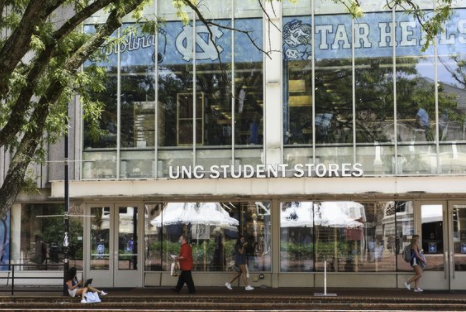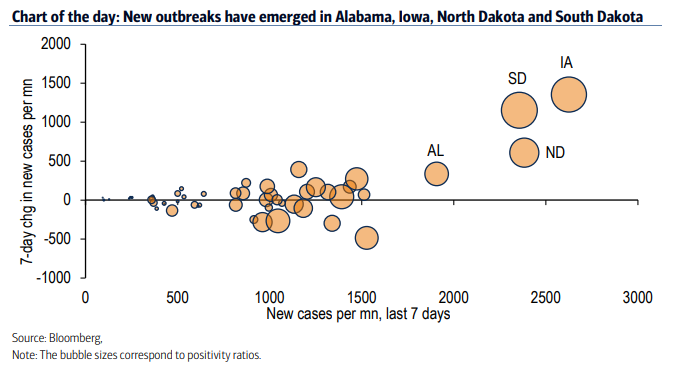Sick Students Flee College Campuses As COVID Outbreaks Rage Tyler Durden Sun, 09/06/2020 - 16:05
The notion that the US will experience a resurgence in COVID-19 cases this fall is almost starting to look like a self-fulfilling prophecy.
A couple of weeks ago, as coronavirus cases were just starting to climb in the state of Iowa, the Daily Iowan, the student newspaper at the University of Iowa, published a harrowing account of one student's trip through the campus quarantine procedure after testing positive for COVID-19 on campus.

The student described confusion and disorder every step of the way, apathetic staff, and substandard living conditions in the "quarantine" dorms. She eventually decided to walk away from it all and return home to Illinois. The student's story wound up in the press after going viral after being shared on student life social media pages.
"I felt like a guinea pig," she told the Daily Iowan.
Since then, Iowa has become host to one of the fastest growing outbreaks in the US.

Outbreaks on college campuses have received growing national attention in recent weeks as more universities opt to send students home, despite a growing scientific consensus that sick students would be better off remaining on campus.
Ravina Kullar, epidemiologist and spokesperson for Infectious Diseases Society of America, said schools should quarantine students on campus, and that students shouldn't be sent home.
Amazingly, schools have rejected this guidance seemingly en masse, risking a repeat of one of the dynamics that definitely helped spread COVID-19 across the country. As Bloomberg reports, schools around the country are increasingly sending students home, often due, it appears, to their own inability to effectively execute hastily organized plans to deal with sick students. Instead of taking responsibility and risking more financial losses.
Some schools have seen infection rates north of 1% for their student populations. Ohio State saw 1.6% of students test positive during the latter half of August.
At Ohio State University, President Kristina Johnson sent an email to the more than 60,000 students, faculty and staff Thursday urging them all to “act as though you are positive” going into Labor Day weekend.
Between Aug. 14 and Sept. 1, about 1.6% of the public flagship’s student population — 1,052 students — contracted the disease. Deans “can pretty much trace” the spread from party to party, and the ability of the university to provide in-person education will rely on students’ restraint, Governor Mike DeWine said at a news conference.
“No one is telling students to hibernate for nine months or the whole year,” he said. “Look, this is the reality: If the numbers get too high and the spread is too much, these schools are going to have absolutely no choice but to pull back.”
But will schools simply do the right thing and "pack it in" if things get out of hand. Maybe some will. But that seems like a naive assumption.
Some students were left adrift after schools abruptly quarantined, or closed, their dorms, due to a cluster of infections. Those unable to find an alternative, perhaps an off campus apartment, might be forced to return home and complete their "semester" online.
As classroom doors close, some students are rushing home. Others are looking for off-campus housing. Many students, parents and administrators are frustrated,
After a flight from New York to Denver and a two-hour car ride, Laurie Meehan and her son Christopher, an 18-year-old freshman, arrived at Colorado College on Aug. 16. He and his two roommates tested negative upon arrival, but his dorm was quarantined Aug. 29. He was told this past week that students had to leave university housing by Sept. 20 and now, he’s quarantining alone in a triple room.
Christopher and his parents would like him to stay in Colorado and take advantage of the outdoor activities.
“He and a number of other students are trying to find housing,” said Laurie Meehan, 52. “Some are looking in mountain towns because there are so many rental properties available.”
Administrators across the country are finding that they grossly underestimated students inability to comply with social distancing restrictions, as they pack on campus bars and outdoor 'dartys' - day parties - during Greek Life rush season. Even without sports, the entire point of going to college, for most of these kids (at least the ones majoring in liberal arts) is partying. And that's one thing you can't do online.
The media has responded by selectively shaming students and fraternities and schools. Many have been kicked off campus, or seen their entire semester's tuition seized and been kicked out, for posting on social media about parties that violated school rules.
The reversals have been predictable, said Robert Kelchen, an associate professor of higher education at Seton Hall University in South Orange, New Jersey. “Colleges told their students most of the summer that things would be reasonably close to normal,” Kelchen said.
“They expected college students to stay to themselves or in very small groups of friends. That’s not how the college experience works."
In Tuscaloosa, University of Alabama students packed bars last month after sororities chose their members on their Bid Day, an annual spectacle that involves herds of undergraduate women racing and cheering before large crowds of onlookers.
A few days before students had returned Aug. 23, the school said only 237 of them had tested positive. The number is now more than 1,200. The university had 450 housing units reserved to quarantine students, but exceeded that capacity in less than a week. The school has received 400 reports of students breaking rules about masks and social distancing, and has removed several from class, according to a memo from President Stuart Bell. Officials haven’t suggested sending students home, saying that would spread the virus to their relatives and communities.
Even the "smart" kids have paid little attention to the Rules. The Detroit News found the bars and hotspots in Ann Arbor packed with students, most of whom ignored social distancing rules as they drank and partied into the night.
But UM is hardly alone among Michigan's public schools.
Central Michigan University now has 260 cases traced to the Aug. 17 return of students, including people living in and around the community, according to the Central Michigan District Health Department that serves six mid-Michigan counties.
USA Today has apparently been keeping a close eye out for stories about students being dismissed without a tuition refund for violating COVID-19 rules. Northeastern University dismissed 11 first-year students after they were discovered partying together in a crowded room at the Westin Hotel in Boston on Wednesday night. They will not receive refunds on their payments for the semester. We imagine the private school's budget really needed that extra $1 million in tuition, when the school has an endowment of more than $1 billion.
While it's easy to dismiss this behavior as reckless young people taking dangerous risks, one professor pointed out that depending on young people to behave any differently was a mistake to begin with, and instead of "shaming" them, schools must find a way to roll with it, so to speak.
Universities didn’t acknowledge the inevitable risk that college students take, said Gavin Yamey, a physician and professor of global health and public policy at Duke University in North Carolina.
“Shaming young people for risky behavior at a time when we know they are in young adulthood, when risk taking is at its peak, is an ineffective public health strategy,” said Yamey, who directs Duke’s Center for Policy Impact in Global Health.
After its student newspaper made a stink about the growing number of cases on campus, UNC became the first school in the country to send students home on Aug 17, despite the fact that this strategy has met with no small degree of criticism from epidemiologists. When confronted with a similarly severe outbreak as UNC, Notre Dame took steps to fight the virus, but opted to keep students on campus. That strategy appears to have paid off.
However, the extreme difficulty schools are having containing the virus probably means that President Trump's wish to see college football revived for the fall season probably won't be granted.
The University of Dayton has the highest number of COVID-19 cases of any college in Ohio, and is among the highest in the Midwest, according to a local TV station report, which cited numbers released from colleges and universities covering the last days of August and first of September. As of its latest data on Aug. 31, University had 771 positive cases and had 55 new daily cases.
via IFTTT
InoreaderURL: SECONDARY LINK
